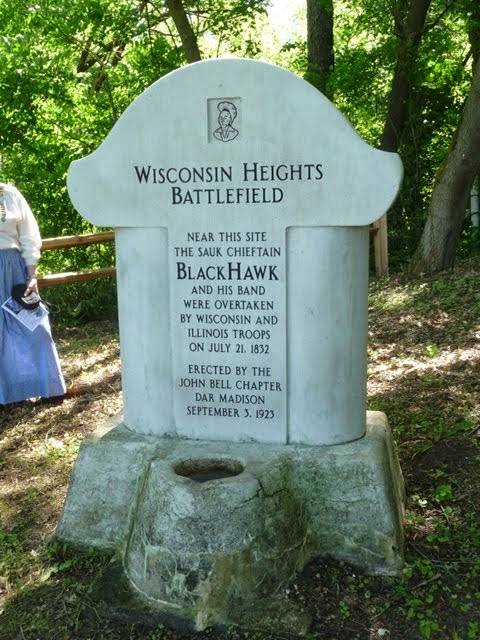 |
| Lake Sinnissippi - near Rock River Rapids Hustisford, WI |
 |
| Henry Dodge |
 At The Four Lakes, on the isthmus between Lake Monona and Lake Mendota, in what is now the heart of Madison, WI, the first sick and elderly stragglers were killed and scalped. The conflict, never a war, had now degraded to malice, mayhem and murder.
At The Four Lakes, on the isthmus between Lake Monona and Lake Mendota, in what is now the heart of Madison, WI, the first sick and elderly stragglers were killed and scalped. The conflict, never a war, had now degraded to malice, mayhem and murder.
Dodge pursued the Indians, now running for their lives, with no time to sleep or eat. On July 21st, 1832, Black Hawk, Neopope and a group of approximately 100 Sauk and Kickapoo warriors once again set up a skirmish line, planning on fighting to the death if necessary, to enable to rest of the non-combatant band to escape across the Wisconsin River. In a small group of hills, Black Hawk formed his strategy against an overwhelming force of 750 or more militiamen. Black Hawk was desperately outnumbered, and the battle was a heavily lopsided victory for the Americans, losing only one soldier compared to as many as 68 of the Indian warriors. One soldier’s description of the events included the words, “Here we were fired on by Indians, and one man was killed and several wounded. We returned their fire with effect, and then charged them, killing a good many, all of whom were scalped by the wild Sucker Volunteers.” Despite the high casualties, Black Hawk held off a vastly superior force, enabling most of his people to escape, a feat which served to impress the military leaders who pursued him.
During the battle, which became known as the Battle of Wisconsin Heights, Ne-o-po-pe tried once again to surrender, but was unable to communicate in English. He shouted that the hungry band was going back across the Mississippi, and would fight no more. With no Ho-Chunk interpreters available to the Americans, the attempt at communication failed.
(Key Terms: Ma-Ka-Tai-Me-She-Kia-Kiak, Black Sparrow Hawk, Black Hawk, 1767, Saukenuk, Pyesa, Rock Island, Black Hawk’s Watch Tower, Black Hawk State Historic Site, Hauberg Museum, Sauk, Sac, Meskwaki, Fox, Rock River, Sinnissippi River, Mississippi River, War of 1812, British Band, Great Britain, Treaty of 1804, Treaties, Ceded Land, William Henry Harrison, Quashquame, Keokuk, Fort Armstrong, Samuel Whiteside, Black Hawk War of 1832, Black Hawk Conflict, Scalp, Great Sauk Trail, Black Hawk Trail, Prophetstown, Wabokieshiek, White Cloud, The Winnebago Prophet, Ne-o-po-pe, Dixon’s Ferry, Isaiah Stillman, The Battle of Stillman’s Run, Old Man’s Creek, Sycamore Creek, Abraham Lincoln, Chief Shabbona, Felix St. Vrain, Lake Koshkonong, Fort Koshkonong, Fort Atkinson, Henry Atkinson, Andrew Jackson, Lewis Cass, Winfield Scott, Chief Black Wolf, Henry Dodge, James Henry, White Crow, Rock River Rapids, The Four Lakes, Battle of Wisconsin Heights, Benjamin Franklin Smith, Wisconsin River, Kickapoo River, Soldier’s Grove, Steamboat Warrior, Steamship Warrior, Fort Crawford, Battle of Bad Axe, Bad Axe Massacre, Joseph M. Street, Antoine LeClaire, Native American, Indian, Michigan Territory, Indiana Territory, Louisiana Territory, Osage, Souix, Potawatomi, Ojibwe, Ottawa, Ho-Chunk)

The B&W image is not that of Henry Dodge. Your numbers of First Nation warriors are understated, while the number of militia ACTUALLY ENGAGED is grossly overstated.
ReplyDeleteDear Newport,
DeleteThank you for your comment. Please feel free to provide corrected information and your sources, for those who are interested in further research on this topic.
The B&W image is Henry Dodge in his later years. If you do a Google Image search, you will be able to see his age progression, which will make identification easier.
You may be correct regarding the numbers of the First Nation warriors and the militia; however, I utilized information from the historic documents I had available to me (see reference section). I am not an educator or a scholar, and I am not working on an advanced degree in history. I am a common everyday person who took a journey and shared the information and lessons I learned on that journey with those who are interested.
What's truly important in this narrative is that a sense of entitlement and ignorant hate led to cruel and inhumane acts. If more precise details are important to you, I invite you do take your own journey and find your own 'truth'. This is my story, and this is what I learned. The most important lesson I learned wasn't found by dissecting every detail, it was discovered by looking at the overall picture and experiencing first hand the importance of love and tolerance, which is a choice we can all make to overcome cruelty and hate!
Namaste,
Theresa